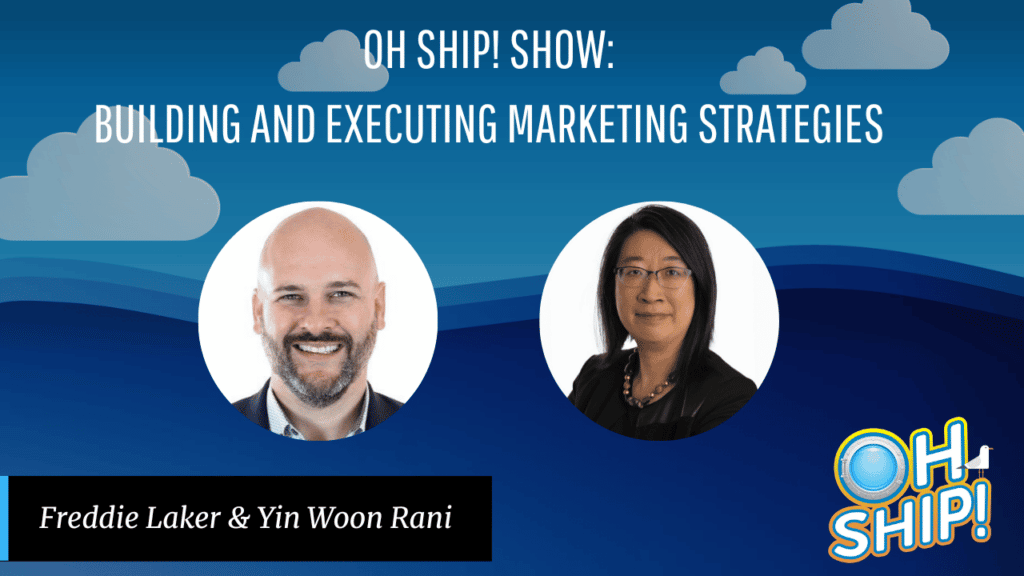Learn why Yin Woon Rani believes marketing success relies on “yes, and” thinking.
Yin Woon Rani is CEO of MilkPEP—yes, the makers of the iconic milk ads! With her robust background as both a marketing leader on the agency side and a CEO, she has abundant insights on building and executing a marketing strategy. She spoke with Freddie about how marketing success isn’t about choosing “this” or “that,” but saying “yes, and.” Read on for a deep dive into what it takes to drive marketing success.
Stewarding heritage while looking to the future
As CEO of MilkPEP, Yin knew she had to uphold the brand’s legacy while keeping things fresh.
“I think the Got Milk? ads are in the top 10 most remembered campaigns ever, so you try to steward that heritage with some care, with some gratitude, with some grace, and you try not to put too much pressure on yourself, too,” she asserts.
To her, it’s about “always trying to do what is right today and finding that balance of honoring their heritage…while making it relevant.”
Dealing with disruption
When Yin assumed the role of CEO right before the pandemic, MilkPEP was an Olympic sponsor for 2020, so she inherited a year’s worth of programming. As they rolled it out, she planned to spend time learning the business. They had a strategy meeting in mid-March of 2020 to prepare for their April launch, and then the headlines about postponing the Olympics came in.
She made the decision to bring back Got Milk? over a weekend. And it turned out to be the right move. Though milk had been on a long-term decline, consumption and sales spiked as people began working and going to school from home. “One of milk’s challenges is that 80% of its consumption is at home, but increasingly people—especially young people and kids—are eating on the go, so it was fascinating to see that when people were home, they were reaching for milk in a very significant way,” says Yin. “In fact, our research shows that it was in the top three most essential grocery items that mothers particularly go shopping for.”
This affirmed that milk’s challenges came down to lifestyle fit. Milk is an extremely affordable and beneficial source of protein and other nutrients, and people love it—it’s just harder to take on the go.
Building strong relationships with agency partners
Forging strong relationships with agencies comes down to alignment and communication, Yin says. Often the teams in an organization aren’t aligned on their activities, even though they ostensibly share a strategy. Organizations need to keep that “north star” in mind, she underscores.
“The other thing I’ve learned, having sat on both sides of the table: You simply cannot communicate enough,” she says. “You cannot communicate frequently enough; you cannot over-communicate.”
Acting as a team
Yin also avoids thinking in “us” and “them” terms. “I really try to think of agencies as an extension of the marketing department, maybe sharing more than I would, giving them more context than they normally would get, and then being open to their feedback,” she says. Clients need to be transparent about what they want, while agencies need to be transparent about their struggles.
How being an agency person makes her a better client
She laughs that she can be the best client in the world or the worst client for an agency. She has a lot of empathy for them and understands how clear client expectations, feedback, and ways of working can result in good or bad work from an agency.
“Sometimes I know too much,” she adds. When they’re not upfront about their struggles, she can tell.
Her experience as a marketer taught her to give the marketing team plenty of room, not acting as a “closet puppetmaster.” “I’m very intentional about where I spend my time as a CEO. I don’t want to be undermining, undercutting the marketing team,” she says.
Designing a contemporary marketing org
What is the role of the agency in marketing today? There’s no one-size-fits-all answer, Yin says. In her agency days, she worked in both PNG and L’Oreal within the hair care category and noticed a dramatic difference in how they approached marketing. Each built an agency solution in a different way. The key is to get clear about what you’re solving for in the partnership.
“I think it’s important to build for today, is what I always say,” Yin continues. “One of the things that’s hard in big organizations is there’s a lot of legacy layers of mindset, process, ops, KPIs, and sometimes we are not keeping pace with the reality of today.”
We’ll be seeing a lot more development on the decentralized side, she predicts. “A lot of organizations are not built for today, and therefore, increasingly not fit for purpose,” she says. More experimentation in structure or practices will help meet the demands of our evolving world.
Moving past “either/or” thinking
Dogmatic headlines like “TV is dead” or “only execution matters” annoy her. “I just don’t think marketing is that simple anymore,” she says. “I think it’s about building the ecosystem and balancing the factors and the tactics against each other, and keeping the outcomes in mind.”
She compares modern marketing to a Rube Goldberg machine, with its complicated moving parts that each play an indispensable role in marketing success. While you may need to double down on certain elements of marketing strategy, you can’t afford to have any weak links.
“Yes, you need to prioritize; yes, you can double down on some things, but you really cannot have any huge outages in the way you think about strategy and execution, data and judgment, creative and media—whatever dichotomy the industry wants to put themselves into,” she says. (“Brand vs. performance” is one of her pet peeves, for instance.) “Be willing to roll in that complexity.”
How to avoid spreading yourself too thin
Have a mindset of openness rather than a bias toward a channel mix, Yin advises. At the same time, don’t spread yourself so thin that you don’t have adequate reach in any channel. “Adding additional channels usually helps, but if you don’t have sufficiency, then don’t bother,” she says. Just make sure you’ve fully outlined a strategy and have a purpose for using each channel, questioning any unfounded bias toward a particular one.
“Apply some critical thinking—basically, act like a scientist,” she urges. Sometimes we rely too much on heuristics, or muscle memory, and it’s vital to move beyond preconceived notions of what the channel mix should be.
Grounding innovation in strategy
Yin shares the following advice on how to center innovation by basing it on your strategy for business growth.
Solving for a foundational problem
“Great innovation is born from foundational strategy and foundational insights around your audience, and how you’re meeting their needs via product or a marketing solution,” she says. “I think sometimes innovation fails because it’s almost like innovation for innovation’s sake. ‘We have to do something new, or this thing is hot.’ There’s nothing wrong with that, as long as you don’t forget the primary role of marketing is to match your consumer with their need and convince, persuade them to some kind of action.’” She’s all for dedicated innovation resources, but they should be targeted at furthering a specific strategy, not out in space. “It needs to be grounded in ‘what are the foundational things we’re solving for,’” she affirms.
Creating alignment in a world of “and”
Silos are necessary to some degree, especially in big orgs, but CEOs and CMOs must work on silo-spanning. “You need to try to create enough horizontal cross-cutting information flow, alignment of objectives, cultural synergy,” she says.
The CEO can garner enterprise-wide alignment by creating cultural expectations as well as systems and processes that will translate those expectations into day-to-day operations. “It is too easy for base and innovation to become not just not aligned, but sometimes competitive to each other because of that war for resources internally,” she notes. Allocate resources collaboratively rather than fueling an internal turf war.
Bringing together data and intuition
Yin loves data, but so much of business judgment, especially on the content side, is intuitive, she says. “I think you need to use the data to inform your intuition, to inform your judgment. I don’t think you can follow it blindly; I don’t think you can ignore it with impunity either.”
She likes to be a good student by absorbing and thinking critically about the data. “But I think, particularly at the CEO level and CMO level, if the data would simply answer it, we wouldn’t have jobs,” she asserts.
This “and” thinking can be used in groups with either a centralized or decentralized decision-making structure, she notes.
The interplay of culture and process
While Yin believes in the saying that “culture eats strategy for lunch,” she emphasizes that both are important. Processes should facilitate culture-building, helping you scale and embed the culture, but your culture has to be ready for that process. Otherwise, the desired changes won’t stick. Because culture is hard to measure, we sometimes underestimate its impact.
Culture is the glue that keeps great talent at your organization; process allows for scalability, posits Freddie.
Taking action on DEI
Businesses and CEOs are finally realizing that DEI has a major impact on business growth, and they’re paying attention to it for that reason, Yin notes. “DEI is no longer optional, and I think people are going to vote with their time and talent and money. But there’s a lot of hand-wringing about how to do it,” she asserts.
While she acknowledges the difficulty of driving change, she emphasizes, “If it was important to you, you would have done it by now. If it was a business imperative like your share price, your EPS, your bonus, your ‘build a plan to put a man on the moon,’ ‘build an electric car’—think of all the impossible things that humans have done—if it was important enough, we would have done it by now.” So now, she’s advocating for the importance of DEI from a business standpoint.
To begin, treat DEI like any other initiative. “If you were tackling any new initiative at your company, you would find expertise, you would find expertise, you would set yourself goals, you would set yourself milestones—real ones—and be able to hold yourself and the organization accountable for them.” Set realistic goals, and start talking about some aspect of the topic.
“Just treat it and measure it and move it along like you would any other part of your business,” she urges.
Find Yin on LinkedIn and follow MilkPEP on Twitter at @GonnaNeedMilk. And be sure to like and subscribe for more great content!









